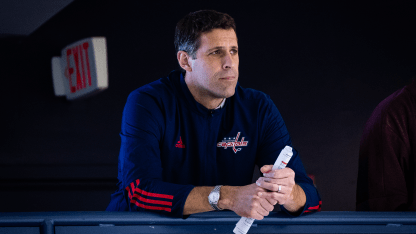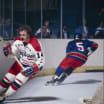Following one of the busiest three-week stretches of offseason in the Caps’ half century history in the NHL, the team made even more news on Monday morning with the announcement of Chris Patrick’s promotion from associate general manager to general manager of the Capitals. That shift in hockey operations personnel was announced concurrently with the elevation of president and previous GM Brian MacLellan to president of hockey operations.
Patrick becomes just the seventh general manager in Washington Capitals franchise history, and he is the first of that group to have been drafted by the team as well; Patrick was the Caps’ eighth-round choice (197th overall) in the 1994 NHL Entry Draft.
“First and foremost, to me it’s an affirmation of what we’ve been doing for the last 10 or 15 years,” says Patrick, son of Caps’ chairman and minority owner Dick Patrick. “And the fact that [majority owner] Ted [Leonsis] has faith in us to be the next step in the leadership for the organization, I think speaks a lot to the group we have and what we’ve built in hockey ops. That was my first reaction.
“For me, this is the only team I’ve ever been around, starting in 1982 [Chris was six then] when my dad got involved. I couldn’t imagine rooting for or cheering for another team. And when I first got involved, I thought that if something like this ever happened, it was probably going to be outside of Washington. I had to get my head around the fact that if it ever happened, I’d have to not be a Caps fan anymore. But the fact that I am able to get this opportunity here is a dream come true for me, for sure.”
MacLellan becomes the first of Washington’s previous half dozen GMs to remain in the organization beyond the conclusion of his tenure in the GM’s chair in the District, a position he rose to 10 years ago this past May. That MacLellan is staying on with the organization is also no surprise. In his 10 seasons on the job, he has helped guide the team to nine playoff appearances and its lone Stanley Cup title, all while compiling the third-best record of any GM in NHL history with 500 or more games.
In 10 seasons at the helm, MacLellan’s Caps teams played to a 449-244-88 record, and the resulting .631 points percentage ranks third behind only Montreal’s Sam Pollock (.685 from 1964-78) and Boston’s Don Sweeney (.665 from 2015-present). During that decade, Washington won its first Stanley Cup title in 2018, it won two Presidents’ Trophies and it won a franchise-record five straight Metropolitan Division titles from 2015-16 through 2019-20.
MacLellan is the third straight Washington general manager to serve at least 10 years at the position. Predecessor McPhee spent 17 seasons on the job after replacing David Poile in 1997. Poile, who will be inducted into the Hockey Hall of Fame this fall, spent 15 seasons as Washington’s GM from 1982-97.
Over the last three weeks, MacLellan and his hockey operations staff – including Chris Patrick – have turned over a third of the team’s roster from the 2023-24 season, engineering a handful of trades and free agent signings to bring seven new players into the organization with just three players from last year’s squad going out the door in the process.
MacLellan will be 66 in October, and after a highly successful decade on the job, he made the decision to pass the torch to Patrick, who has served a longer apprenticeship in the game than any of his three predecessors in the GM’s chair. The 48-year-old Chris Patrick has spent the last 16 seasons – fully a third of his life to this point – working his way up the organizational ladder to become the seventh GM in franchise history.
Last season, Patrick began to travel more with the team, an indication that MacLellan might be thinking of transitioning his associate GM into the position. Once upon a time in the NHL, it was not uncommon for one person to hold both the head coach and GM positions of a team simultaneously. But over the years, the depth and breadth of the job has expanded to the point where few would dream of holding down both jobs, except in short-term, emergency situations.
These days, most NHL teams have multiple assistant GMs and many teams have already gone with the model that Washington is choosing with Monday’s move, separating the GM position from the head of hockey operations, twin roles that MacLellan held until Monday morning.
“Mac has earned all of the accolades and has all the responsibility for hockey operations,” says Leonsis. “And these businesses have gotten much bigger, with much more sophisticated needs. Chris was the obvious candidate to be the general manager. Being a GM is much more challenging and time consuming of a job as well. For modern day NHL hockey operations – especially in a big market – you need to have a president and a GM, and we [also] have a chairman [in Dick Patrick].
“So we are in really, really good hands; we’ve been in good hands for 25 years since I’ve owned the team, and I think this is just a natural evolution of the organization. The continuity has been a key to our success, and it shows.”
That continuity includes Chris Patrick, who has connections with each of his three predecessors in the GM’s chair. Poile drafted Patrick in the 1994 NHL Entry Draft, McPhee hired him into the organization in 2008, and MacLellan has worked closely with him for the last 10 years.
After graduation from Princeton in 1998, Patrick earned an MBA from the Darden School of Business at University of Virginia in 2006. Patrick then went to work in the financial industry, taking a path similar to the one MacLellan himself had taken to the post. When Patrick expressed a desire to explore possible employment in the hockey world in 2008, it was McPhee who insisted that if Chris was going to work in hockey, he was going to work for the Capitals.
“I mentioned to George that Chris was going be home around Thanksgiving time and wanted to talk to him about what opportunities were in hockey, and what his advice would be,” Dick Patrick told me a few years back. “George said, ‘If he’s going to work in hockey, he’s going to work for us.’ I just sort of stayed out of it at that point.
“They worked something out. I’m sure it was much less lucrative than the job path he was on; in hockey there’s not that many great jobs. But I asked him how he likes his job and he said that he loves it. He just loves doing it, going to scout players, and being a part of it. The people in hockey are such great people, and that always makes it nice, when you’re working around people that you like.”
Patrick started by doing some part-time scouting, and he was appointed as a pro scout in 2010. When MacLellan took over the reins as GM in 2014, Patrick was elevated to director of player personnel, a job that entailed managing the team’s relationship with its AHL Hershey affiliate and managing Washington’s pro scouting staff.
Two years later, the Bears reached the Calder Cup final, only to fall to Cleveland. Two years after that, Dick and Chris Patrick became the sixth and seventh members of the Patrick family to have their names eternally etched onto the Stanley Cup.
In 2021, Patrick was promoted to assistant general manager. He has hired two AHL coaches of the year – Spencer Carbery and Todd Nelson – the former of whom will be entering his second season as the Caps’ bench boss this fall.
A year ago, Patrick was elevated to associate GM. In that position, he oversaw pro scouting, analytics and player contract negotiations. He was clearly on the GM track at that point, and a pair of back-to-back Calder Cup titles – the second set of back-to-back Calder Cup crowns in less than 20 years – has resulted in yet another promotion this summer.
Chris Patrick will report to MacLellan, who in turn reports to Dick Patrick, the team’s venerable chairman and minority owner. Dick Patrick joined the Capitals in the summer of 1982 as team president, and one of his first tasks after taking that position was the hiring of Poile in August of 1982.
Dick Patrick hired McPhee some 15 years later, and he hired MacLellan 10 years ago in May. On Monday, MacLellan hired Chris Patrick as his own replacement.
“Chris has done every job in the company and he is the right age; that’s what you always look at in terms of development,” says Leonsis. “It’s not like he hasn’t paid his dues and it’s not like everything he has touched hasn’t been successful.
“I look at Hershey as being a big part of our success. When we went through the [full-season] lockout [in 2004-05], there were three things we were going to do: We were going to build the team around young players, we were going to rebuild our training facility [in Ballston], and we were going to change out and rebuild our AHL franchise.
“We did all three of those at the same time. We moved from Portland to Hershey, and I think Hershey is a big part of why we’re a great organization. They’re one of the great franchises in pro sports, and they want to be associated with us, and Chris has run [that part of the operation] for us. I know I have a lot of Hershey rings, and I’m getting another one now. I think that’s five of them in just under 20 years.”
That’s correct, and there were a couple other seasons (2006-07 and 2015-16) that ended with losses in the Calder Cup final series.
“We have the right mix of experience and youth and vigor,” observes Leonsis. “Spencer is the youngest coach in the League, and Chris is probably one of the youngest GMs in the League. That’s what we should be doing, that’s how you look towards the future. But it’s not like Chris is a rookie; he has been with us for 16 years.”
He has, and he has been an integral part of some great organizational successes over that time, most of which are documented above. One of the successes that’s not documented above is the Capitals’ success at identifying and then bringing in players from other organizations via trade or free agency. As a key figure in the pro scouting department, Patrick was directly involved in this element of the organization.
Once those players arrived in D.C., a great number of them enjoyed the area, the culture, the workplace, and the Washington hockey environment that MacLellan and his staff built up over the last decade, so they signed on to another contract to stay longer. The list of such players includes: T.J. Oshie, Brett Connolly, Lars Eller, Michael Kempny, Devante Smith-Pelley, Nic Dowd, Carl Hagelin, Nick Jensen, Brenden Dillon, Conor Sheary, Trevor van Riemsdyk, Matt Irwin, Nicolas Aubé-Kubel, Sonny Milano, Dylan Strome and Rasmus Sandin.
It’s a remarkable list. But Patrick and the pro scouting staff didn’t just look for warm bodies, they were always seeking a fit, as he notes in the midst of discussing his vision for the Caps in the post-Alex Ovechkin era.
“A lot of that will be determined by where the team is and what it looks like, and that’s where Mac and I will work together to determine the evolution and the strategy with the team,” says Chris Patrick. “But for me personally, I think there are plenty of examples out there of teams being able to – for lack of a better term – retool or rebuild on the fly.
“It’s a little bit of a different situation, but if you look at the last two expansion teams, essentially they are supposed to be picking from a pool of what are supposed to be third line players and number five [defensemen], but they end up getting pretty good teams out of it. There are good players out there, and I think you have to be smart about finding the right players, and how they fit in your team and your structure, and how you want to play the game.
“The tear down/rebuild model, we had success with it one time. But there are a lot of teams that have tried it and have not had that success. And you can get stuck in a never-ending cycle of just not having the right personnel, and then having to do it again. If you decide to go that way, you have to be eyes wide open, and that’s no secret around the League anymore. I feel like when we did it, it hadn’t been done a lot. Now, there’s been several teams that have attempted to do it, with varying levels of success.
“I look at other teams in the League that have not done that, and that have been competitive over the last couple of playoffs, and it gives me hope that we’ll be able to maintain that winning culture and winning environment here without having to go through a huge, painful rebuild. But again, we will see where we’re at; the team dictates it.”
Since winning the Stanley Cup six years ago, the Caps have gradually replenished what had been a virtually barren farm system at the time, and they’ve also matriculated a few drafted and developed players to the varsity roster over that span, players such as Martin Fehervary, Alex Alexeyev and Connor McMichael. Others are on the cusp of nailing down permanent roles in the District.
In the last three weeks, the Caps have managed to get younger and faster via a series of trades and free agent signings. That work will continue as Patrick and MacLellan continue to collaborate as they’ve done for the last decade. And in the wake of Patrick’s promotion, two other longtime hockey ops stalwarts will step up to take on Patrick’s previous responsibilities. Longtime pro scout and former Caps center Brian Sutherby will now manage the pro scouting department, and Jason Fitzsimmons will take over as the team’s liaison between Washington and Hershey.
Ten years ago, the Caps reaped the benefits of hiring a new general manager from within. It was the first time they’d ever gone that route; every prior GM in franchise history prior to MacLellan had been brought in from outside the organization. Now, they’re taking that path again. Patrick can hit the ground running, and he can do so with a staff he has worked alongside for years.
“For sure it helps me with my familiarity, but I think it helps a lot with the people within the organization, too,” notes Patrick. “We have relationships already, and they’re comfortable with me and there isn’t that feeling out period with me.
“If I were to get this opportunity with another team, I would have been calling Mac and asking him for permission to interview five or six guys and try to bring them over, and maybe if he was nice, he’d let me bring one. That is a huge advantage. We have a team in place that I fully trust and that I think are the best in the business, and to come into that situation is an opportunity you don’t get a lot. Usually with this job, you’re coming into a situation where things have gone sideways and you’re coming in to change things up, and it takes a while to get all of the pieces into place. To be able to walk into a situation like this is definitely a nice advantage for me.”
In the hockey media, the word “chemistry” is used more than a lot of actual hockey terms. It’s typically used to assess the comfortability – or lack thereof – among players playing on the same line or the same defense pairing.
The Caps’ strong locker room culture has been instrumental in attracting and retaining talent from outside the organization, but that culture and that positive chemistry are also very evident among the Washington hockey ops staff and the coaching staff as well. People enjoy one another’s company, they enjoy working and solving problems and vexing issues together, and it has translated into positive results on the ice.
That’s something that is important to Patrick, and something he intends to continue to foster going forward.
“That’s actually where I feel like I draw a little bit from my ‘outside’ work experience,” he says, “because I felt like even when I was working in finance, I was lucky to work with really good people, and it was fun to come to work. It was engaging. There were smart people and they challenged you, but they didn’t bully you or intimidate you. But they expected high quality work.
“I feel like it’s the same environment we have here, where you respect everyone you work with. It doesn’t mean you always agree with them; we don’t want people to each other to agree all the time, right? But as long as there is that mutual respect for each other, and an understanding at the end of the day that we’re all playing for the same team and working toward the same goal, then you can have good, healthy debates and come to a better decision-making process because of it. We’ve built that environment over the years here, and I think one of the reasons we’ve been successful is that when people come here, they don’t really want to leave.”



















